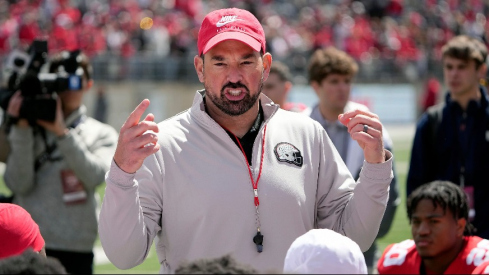Like it or not, College Football Playoff expansion is coming.
While it still has to be approved by the full CFP management committee and board of managers, and won’t start until 2023 at the earliest, the wheels are in motion for the CFP to expand to 12 teams in the near future.
For Group of 5 teams who will now have a real chance to make the playoff, that’s certainly good news. Most Power 5 teams should clearly benefit from playoff expansion, too, considering that only 11 different schools have made the field in the first seven years of the four-team CFP. For a program like Ohio State who has made the four-team playoff more often than not, though, playoff expansion will come with both pros and cons.
Why should Ohio State and its fans be excited about playoff expansion, and what aspects of expansion might make life harder for the Buckeyes? We take a look at both below.
Pro: Easier to make the playoff
This is the most obvious benefit of CFP expansion for everyone, including Ohio State. While the Buckeyes have made four of the seven four-team playoffs so far, they would have made a 12-team CFP in all seven years (based on their top-12 standings in the final CFP rankings). Using the BCS standings before 2014, Ohio State would have made a 12-team playoff in 16 of the last 20 seasons.
Given what Ryan Day has done both on the field and on the recruiting trail so far in his tenure as head coach, the Buckeyes should be positioned to make a 12-team playoff just about every year for the foreseeable future.
Con: One more game to win
While the expansion to 12 teams will make it easier to qualify for the playoff, it will make it harder for teams to actually win the playoff once they get there.
For a team like Ohio State that’s perennially in the hunt for a top-four seed, that might be a net negative. While the top four seeds will get a first-round bye, they’ll still have to win one more game – against one of the top 12 teams in the country – to get to the national championship game than they’ve had to in past years.
Teams who are seeded 5-12 will have to win two more games than previous playoff participants to make the national championship game – but for those teams, the new format will obviously still be a net positive, as they wouldn’t have even been in the playoff in past years.
Pro: More margin for error
Ohio State and its fans will no longer have to live in perpetual fear of one regular-season loss ending the Buckeyes’ national championship hopes. In a 12-team playoff, an 11-1 regular season record will easily be good enough to get the Buckeyes into the field every year. 10-2 will likely be good enough to get Ohio State in most years; 9-3 might even give the Buckeyes a shot.
Consider a scenario like the one the Buckeyes have going into this season, when they’ll be starting the year with two challenging games on the road at Minnesota and at home against Oregon all while breaking in a brand new starting quarterback, and Ryan Day would probably love to have that extra cushion this year. And while the stakes for every regular-season game won’t be quite as high as they’ve been in the past, it could allow fans to enjoy the twists and turns of the regular season more, knowing that one loss isn’t the end-all, be-all for a team’s national title chances.
Con: Less reward for dominance
While a margin for error is nice to have when you need it, Ohio State didn’t need it in either of the last two seasons, when the Buckeyes went undefeated in the regular season to secure their place in the top four. And while the Buckeyes will surely still be aiming for perfection going forward, there won’t be as much reward for teams who have dominant regular seasons as there has been in the past.
Getting a top-four seed and the first-round bye that comes with it will certainly still give Ohio State incentive to have the best regular season possible each year. Getting a guaranteed spot in the quarterfinals, though, doesn’t give the teams who have the best regular seasons the same kind of championship-winning odds they’ve had with a guaranteed spot in the semifinals.
Pro: Tangible reward for winning the Big Ten
Although the recommended format for the 12-team playoff doesn’t guarantee a berth for any conference – rather, it guarantees berths for the six highest-ranked conference champions in the final CFP standings – it’s a near-certainty that Ohio State will make the 12-team playoff in any year that it wins the Big Ten championship, which is good news for a program that’s won the last four Big Ten championships, yet missed the playoff despite winning the conference in both 2017 and 2018.
Furthermore, only conference champions would be eligible to earn a top-four seed under the recommended format, adding tangible value to winning a conference championship that does not exist under the current playoff format.
If Ohio State can continue to dominate the Big Ten the way it has in recent years, the Buckeyes should be well-positioned to not only make the playoff but be one of its top seeds year in and year out.
Pro: More incentive for marquee non-conference games
More marquee non-conference games isn’t a guaranteed outcome of a 12-team playoff – to the contrary, some believe it will actually give teams less incentive to schedule fewer non-conference games against top competition – but for teams like Ohio State that typically win the vast majority of their conference games, I believe playoff expansion will give the Buckeyes more reason to schedule the non-conference matchups everyone wants to see.
Since non-conference losses don’t affect a team’s chances of winning a conference championship, and one loss in September will no longer derail a team’s playoff hopes, the reward of winning a big non-conference game – and the financial benefits of those games – could outweigh the risk of taking an L early in the year.
Whether that actually comes to pass could depend on whether the College Football Playoff selection committee shows it will reward teams for strong non-conference wins more than it punishes teams for non-conference losses.
The way Ohio State has stacked its non-conference schedules over the next decade, though, suggests that the Buckeyes will be scheduling marquee early-season games more aggressively than ever going forward. When Ohio State and Alabama announced last summer that they would play a home-and-home series against each other in 2027 and 2028, many observers took that as a sign that they thought the playoff would be expanded by then, and it’s likely Ohio State athletic director Gene Smith and Alabama athletic director Greg Byrne already knew then that playoff expansion talks were in the works.
Con: More parity isn’t what Ohio State needs
From a national perspective, the potential for more parity is one of the biggest arguments in favor of expanding the College Football Playoff. Most college football fans are sick of seeing Alabama, Clemson and Ohio State in the final four every year, so the potential for a wider variety of teams to contend for the national title is one of the biggest reasons why playoff expansion is happening.
Ohio State would probably prefer the current imbalance of power that favors it, though. The Buckeyes are still likely to make the playoff on a more consistent basis than just about any other team (if not every other team), but if more teams can start making the CFP and contending for titles on even a semi-regular basis, they’ll have a stronger pitch to elite recruits who want to attend a school where they’ll have the chance to compete for a national championship.
Playoff expansion isn’t going to eliminate Ohio State’s status as a college football power, and as long as the Buckeyes make the playoff and win games in the playoff on a regular basis, they’ll continue to have one of the strongest recruiting pitches in the country. But playoff expansion might narrow the gap a little between the haves and have-nots.
Pro: Potential home games at Ohio Stadium
How much of a pro this will actually be depends on whether the College Football Playoff responds to backlash and gives the top four seeds the opportunity to host quarterfinal games at their home stadiums. The current recommendation is for only first-round games to be played at campus sites, with the quarterfinals, semifinals and final all played at bowl sites, but there’s been significant backlash to that proposal – if the 5-8 seeds get to host games, why shouldn’t 1-4? – that will likely lead to more discussions over the next couple of weeks.
Nevertheless, the possibility that Ohio State could host future playoff games at Ohio Stadium is now a very real one, giving college football fans something they have wanted to see for years. If you’re an Ohio State football fan, you’ve probably dreamed about the possibility of a Southern team having to travel north to play in the Shoe in front of a crowd full of Buckeye fans in the cold weather of late December or early January; in a few years, that could actually happen.
However, Ohio State would undoubtedly be more excited about hosting a home playoff game as a reward for being one of the top four seeds in the CFP rather than as a consolation prize for being a fifth, sixth, seventh or eighth seed. Either one would be fun for the Buckeyes and their fans, but we can hope CFP decision-makers will do the right thing and play both the first and second rounds of the 12-team playoff at the higher seeds’ home stadiums.

Pro: More money
There are plenty of football-motivated reasons for expanding the College Football Playoff, but we can’t ignore the biggest reason why the CFP is expanding to 12 teams: It’s gonna generate a lot of revenue.
While the working group that recommended the 12-team playoff has been exploring the possibility of expansion since before the COVID-19 pandemic started, it’s still probably no coincidence that momentum to expand the playoff has increased rapidly after a year in which every college athletic department in the country lost money.
The Ohio State athletic department’s deficit for the 2021 fiscal year is projected to be around $50 million, but playoff expansion should help Ohio State make up that money later this decade, as an expanded playoff will bring a revenue influx to athletic departments throughout the Football Bowl Subdivision.
Of course, that will lead to increased scrutiny about the NCAA’s amateurism rules that prevent the athletes playing in those games to get a direct cut of the money themselves. U.S. Senator Chris Murphy, who has introduced multiple bills in the Senate designed to give college athletes more rights, criticized playoff expansion as “another example of the big-time college sports executives and administrators making decisions just to increase their own revenue, while continuing to put the needs and health of college athletes on the back burner.”
That said, increased CFP revenue will go a long way toward Ohio State being able to continue funding 36 varsity sports and all the other resources it provides to Buckeye athletes.


